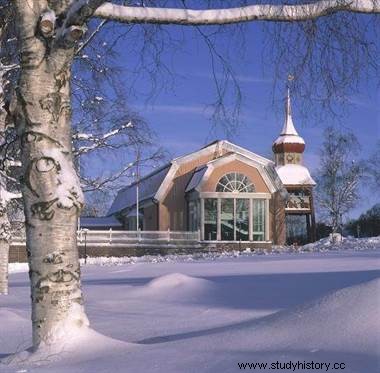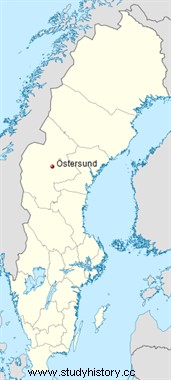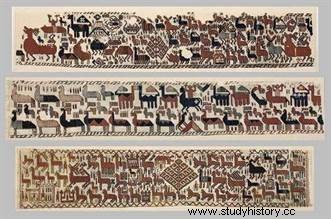 Located in the Jamtli Museum , in Östersund, Sweden, the Överhogdal Tapestry is a unique relic from the Viking Age. Dating, according to several estimates, from the beginning of the 11th century, it was incredibly well preserved. This masterpiece could correspond to the famous Bayeux tapestry.
Located in the Jamtli Museum , in Östersund, Sweden, the Överhogdal Tapestry is a unique relic from the Viking Age. Dating, according to several estimates, from the beginning of the 11th century, it was incredibly well preserved. This masterpiece could correspond to the famous Bayeux tapestry.
The Överhogdal Tapestry:an unexpected find
This tapestry was discovered in the barn of the church of Överhogdal, a village in the Jamtland region, in the heart of Sweden, by the artist Paul Jonze in 1910. He then took this tapestry to Östersund to show it to Ellen Widén, wife of the prefect who was a key figure in the promotion of regional heritage. She washed them in her bathtub, fortunately the tapestry resisted this treatment. A year later in 1911, during a stay in Överhogdal, Helena Öberg discovered three new fragments detached from the main room.
 « When Paul Jonze found the tapestry it was not quite complete, it was missing some fragments on the right side. says Torgärd Notelid, Head of Exhibitions, Learning and Public Service at the Jamtli Museum. To try to find the missing parts Helena Öberg left for Överhogdal the following year. “When she arrived at the church, she met an old man who asked her the purpose of her visit. She jokingly replied that she was looking for the missing part of the tapestry. He then says to follow him to his house, where she could find one of these famous pieces. When they arrived at the humble abode, there was only a little girl playing with dolls. »
« When Paul Jonze found the tapestry it was not quite complete, it was missing some fragments on the right side. says Torgärd Notelid, Head of Exhibitions, Learning and Public Service at the Jamtli Museum. To try to find the missing parts Helena Öberg left for Överhogdal the following year. “When she arrived at the church, she met an old man who asked her the purpose of her visit. She jokingly replied that she was looking for the missing part of the tapestry. He then says to follow him to his house, where she could find one of these famous pieces. When they arrived at the humble abode, there was only a little girl playing with dolls. »
The old man then asked her where the doll's blanket was, the little one pointed to an old cabinet. At the same time the child's mother arrived and took the blanket out of the closet, which happened to be one of the missing pieces. The little girl refused to give it and began to cry. Helena then gave her two crowns and promised her a new blanket for the doll, which she then did...
The next day she went to church where two men were making repairs. When she told them what she was looking for, one of the men pulled out a piece of cloth from his apron pocket. He had found it under the pulpit stairs while looking for a rag to clean a lamp. As "the rag" was too thick he had put it in his pocket. They searched under the stairs again and found another piece of the tapestry.
An ancestral technique
When discovered, the Överhogdal Tapestry consisted of three long Sumak panels measuring 200x35 cm. Sumak is one of the oldest weaving techniques, it was used all over the world, before being abandoned for simpler and faster techniques. We surround the even threads of the warp then we bring forward the weft thread to surround the odd thread. This is the same technique used for Sumak oriental rugs.
The background of the tapestry is made of linen threads while the design is of two woolen threads. The wool comes from sheep in the Jamtland region. The wool was then dyed with herbal decoctions. For the red we used madder, blue woad and probably yellow with bearberry. To get the green we had to mix yellow with woad.
Mysterious patterns
 On the scene on the left we can easily observe that the symbols are of Christian inspiration (crosses and churches). It is quite interesting to see Christian symbols on a canvas from the Viking era. This lets us understand the speed and impact that Christianization had in the Nordic countries.
On the scene on the left we can easily observe that the symbols are of Christian inspiration (crosses and churches). It is quite interesting to see Christian symbols on a canvas from the Viking era. This lets us understand the speed and impact that Christianization had in the Nordic countries.
Torgärd Notelid helps us understand the tapestry:“Everywhere there are animals and characters of all kinds. They are horses with four or six legs, moose, reindeer or stags with magnificent antlers and tails with bizarre shapes in meanders, birds, dogs and unknown fabulous animals. All head to the left of the tapestry. Between the animals are insignificant figures of men and here and there more important figures. There are also ships, buildings, trees of life, and signs of various kinds. The characters are not chosen at random but want to tell a story. The question is:what do we want to describe? »
A number of interpretations have been presented. When it comes to the left side of the tapestry most agree on a Christian-inspired meaning, the churches and crosses bear witness to this. But on the other hand when it comes to interpreting the other two parts, the hypotheses are completely different...
Article written by Paul Humbert, Clémentine Lourme and Marion Brancourt for Histoire-pour-tous, June 2014.
